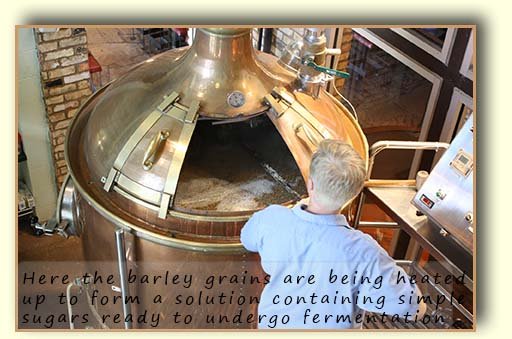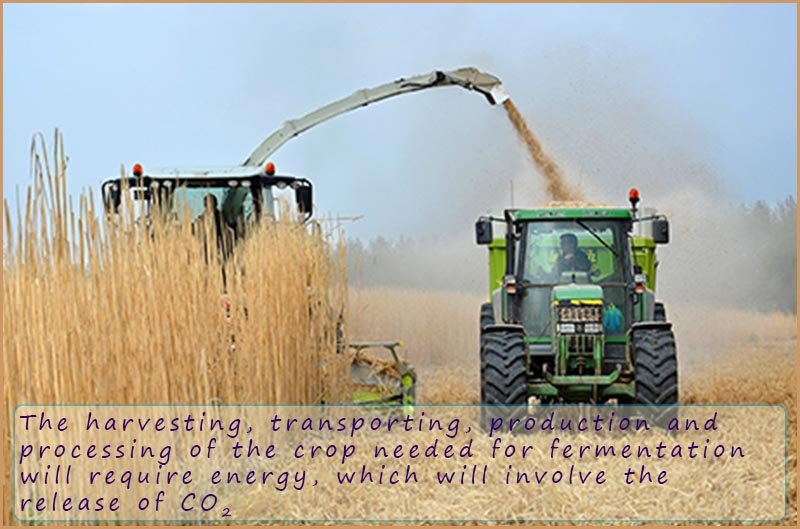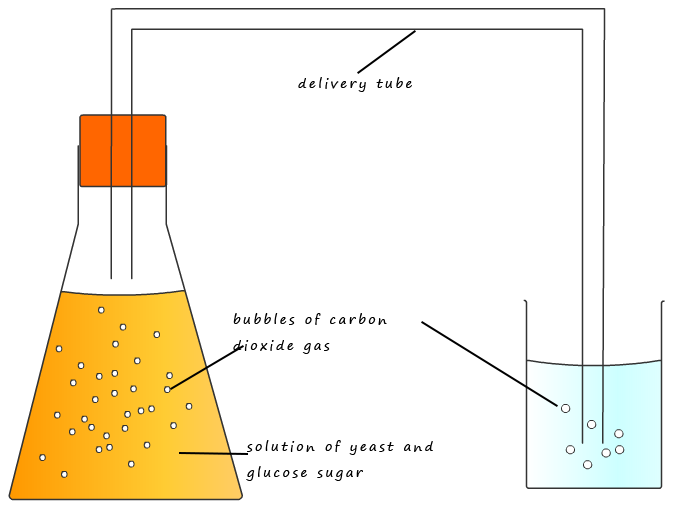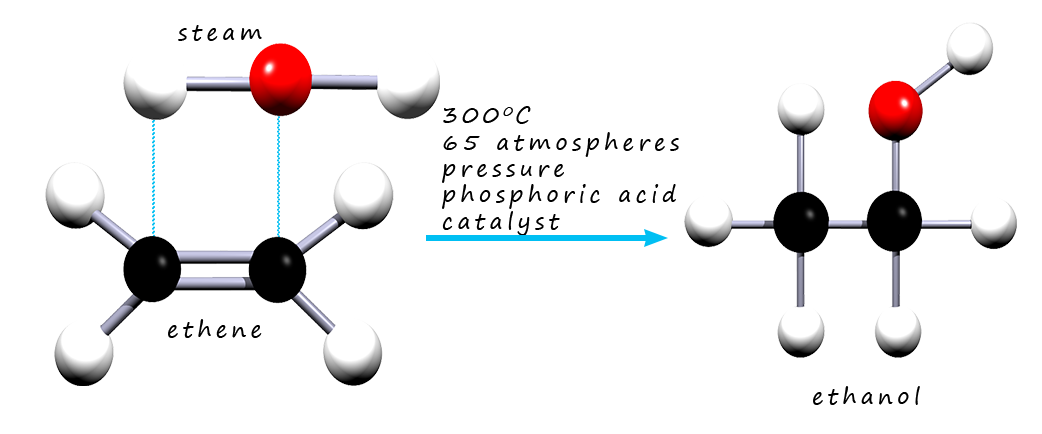


 The word alcohol is most commonly associated with alcoholic drinks,
unfortunately most alcohols are toxic and are definitely
not suitable as drinks. The one alcohol
which is less harmful is ethanol, although it still causes many people to do very silly things when
taken in excess! Ethanol has been made for thousands of years as an alcoholic drink in
a process called fermentation.
As an example consider how beer is made.
The word alcohol is most commonly associated with alcoholic drinks,
unfortunately most alcohols are toxic and are definitely
not suitable as drinks. The one alcohol
which is less harmful is ethanol, although it still causes many people to do very silly things when
taken in excess! Ethanol has been made for thousands of years as an alcoholic drink in
a process called fermentation.
As an example consider how beer is made.
To make beer, barley or sometimes oat grains are allowed to
start germinating by being placed in water. After a few days naturally
occurring enzymes
break down the starch present in the grains into the sugar maltose. This process is called malting. The
germinated barley grains are then dried by hot air .
These dried grains are often called
malt. Hops are then added to give the beer its bitter taste and aroma.
The barley grains are then lightly crushed in a process called milling and
finally the grains are transferred to large
tanks filled with hot water where the starch in the barley grains is converted into
simple sugars by naturally occurring
enzymes present in the barley. These simple sugars
dissolve in the water to form a solution which is often called "sweet wort".
This sweet wort is then transferred to copper vessels where it is boiled. The left over grains, often called brewers grains are
sold as animal or cattle feed.
Once the sweet wort solution has cooled, it is transferred into large fermentation
tanks where the yeast is added. Yeast is a
natural fungus which will
produce an enzyme called zymase which will convert the simple sugars in the solution into carbon dioxide gas and the
alcohol ethanol. This is fermentation.
The fermentation process is slow and can take days or even weeks. Fermentation is a natural process, it is a form of anaerobic respiration. An equation for fermentation is:
The ethanol produced by fermentation can also be used as a biofuel. Biofuels are a renewable source of energy since they are produced from plant based materials e.g. sugarcane in Brazil and corn in the USA are grown and then fermented to form ethanol which is used as a biofuel for cars. These biofuels are often thought of as being carbon neutral because the amount of carbon dioxide released into the atmosphere when they burned added to the amount of carbon dioxide released during the fermentation process should be equal to the amount of carbon dioxide removed from the atmosphere during the photosynthesis process which took place in the plant to produce sugars which then were fermented, this is outlined in the table below:
| Removal of carbon dioxide from the atmosphere | Addition of carbon dioxide to the atmopshere |
|---|---|
|
Photosynthesis
6CO2 + 6H20 → C6H12O6 + 6O2 Here 6 moles of CO2 gas are removed for every mole of glucose formed. |
Fermentation
C6H12O6 → 2C2H5OH + 2CO2 Here 2 moles of CO2 are released for every mole of glucose fermented. Combustion 2C2H5OH + 6O2 → 4CO2 + 6H20 Here 4 moles of CO2 are released into the atmosphere for every 2 moles of ethanol burned. |
| Total number of moles of CO2 removed = 6 moles | Total number of moles of CO2 released = 6 moles |
By studying the information in the table at first glance it would appear that the use of biofuels is indeed a carbon neutral process, however this may not be the whole story and we need to consider the "hidden carbon dioxide" released in the production and use of these biofuels.

The information in the table above might suggest that using ethanol as a biofuel is indeed a carbon neutral process. However
the information in the table can be a little misleading since you should consider all the additional processes that are required
to produce the ethanol in the first place. For example the additional CO2 that will be released by the harvesting, transporting
and production of the ethanol by fermentation.
Similarly if the ethanol is used as a biofuel it will need additional processing and transport to where it is to be used. This will also
release additional CO2 into the atmosphere. However there is also increasing concern about the land used to produce
biofuels. The land
used to grow the crops needed for the production of these biofuels is often not ethically sourced, this often means that tropical rain forests are being cleared
to make way for crops to be grown and then fermented to produce
biofuels. With a growing world population and the increasing demand
for food it seems unethical to be growing crops to fuel cars when millions of people are simply not getting enough food to eat.
 Yeast is a fungus, a living organism that will produces enzymes
that convert the sugar glucose into ethanol, this process is a form
of anaerobic respiration. That is respiration without oxygen present, this anaerobic process works best around 370C - body temperature. If the fermenting
solution gets too hot then the yeast
will be killed and fermentation will stop. If the solution is kept too
cold then obviously fermentation
will be very slow. Air also needs to be excluded since bacteria and oxygen present in the air will oxidise the
ethanol produced into ethanoic acid (vinegar).
Yeast is a fungus, a living organism that will produces enzymes
that convert the sugar glucose into ethanol, this process is a form
of anaerobic respiration. That is respiration without oxygen present, this anaerobic process works best around 370C - body temperature. If the fermenting
solution gets too hot then the yeast
will be killed and fermentation will stop. If the solution is kept too
cold then obviously fermentation
will be very slow. Air also needs to be excluded since bacteria and oxygen present in the air will oxidise the
ethanol produced into ethanoic acid (vinegar).Alcohol (ethanol) used in alcoholic drinks such as beer, wine and spirits is made by fermentation. However alcohol can also be made a method called direct hydration. Using this method produces alcohol very quickly and being the only substance made there is no waste and no costs are needed in separating out unwanted substance. It is also a continuous process whereas traditional fermentation is a batch process. This makes direct hydration much more cost effective and more efficient, however is a non-renewable process since the ethene needed for it comes from crude oil.
Alcohol used for industrial purposes such as solvents and in sanitisers will be made by the direct hydration method rather than fermentation. Direct hydration involves adding steam across the C=C in an alkene molecule, usually ethene. The reaction is shown below. A catalyst (phosphoric acid) and a high temperature (3000C) and high pressure (65 atmospheres) are both needed to get this reaction to occur smoothly.

Equations for this reaction are: